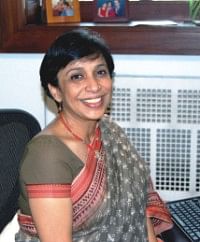| Home - Back Issues - The Team - Contact Us |
 |
| Volume 10 |Issue 20 | May 27, 2011 | |
|
|
Interview Taking the Quieter Journey FARHANA URMEE
Growing up in a culturally inclined household, Dr Kanta Jamil, daughter of renowned dancer couple Raushan Jamil and Gauhar Jamil (also a well known actress) decided to take a path that was quite different from that of her parents. Despite her natural passion for dance she did not pursue it as a profession. Although Nataraja has a special place in her heart, she moved away from the lure of being an artiste and found another way to contribute to her country's development. She is at present working as a Monitoring and Evaluation Advisor in the Office of Population, Health and Nutrition and Education, USAID. The latest research she has spearheaded is on maternal mortality and health care. In an exclusive interview with The Star on the eve of Safe Motherhood Day (May 28), she talks about why she swayed away from the expected path of performing arts to the quieter arena of research and what implications her work has on the development of the country. Why did you, coming from such a cultural family, instead of going into the performing arts choose your profession in development research? Pursuing my Bachelors and Masters in Economics and further pursuing PhD in Health and Population was not actually due to any deliberate planning. It just happened and I only knew I had to do something. Getting scholarships made it easier to study abroad. I had already seen the hardship my parents had to face while bearing the cost of my education while I was studying in English medium school. It was my mother who always used to think that girl children needed more support than the boys. When my parents let me go to English medium school it was real hard for them to pay the fees for their three daughters. My mother, who was always a free thinker and a progressive woman, sent her daughters to an English medium school and sons to a Bangla medium school because they could not afford tuition fees for English medium school for all five of us. I saw the hardship, probably that led me to study hard. The environment, in which we grew up, obviously was not appropriate for studying as there were music playing on, the rush of students coming for dance classes. Even my siblings and I were involved in dancing, singing, playing Tabla. I used to wake up at 5am and continue studying till 8am as I knew I was not going to get any calm environment to study after 8. When you went abroad to study did you disassociate yourself from this artistic environment? What is the most exciting work you have been engaged in which has given you immense satisfaction? Why is it important to do such surveys? If the government wants to curb maternal mortality, it has to know why the problem is occurring; the cause of the problem will shed light on the way out of it. Thus the findings of such research can advocate a policy direction in solving problems. Further, depending on the findings of such surveys new programmes and projects might be taken. Above all, promoting the survey findings helps to create awareness among people in health and population issue. For decades 90 percent of expectant women were having their deliveries at home, often they wanted to go to a health centre but did not get support from the household level or they did not want to go unless there is a complication; again they did not know where to get the delivery facility. Reduction of child marriage is another factor working behind the decline. I think, women are getting more aware than before and are willing to take health facilities if they are provided. Again, more women are getting educated than ever before and of course maternal health and mortality are becoming a talked about issues. Maternity health is not just about preventing the deaths of mothers while giving birth, having a sound health throughout their lives is crucial for mothers. Yet having the decline at an average of about 5.5 percent per year is a great achievement in attaining the MDG targets. But it is important to hold the trend of decline, and there is much more to do in this regard. The government needs to ensure the delivery facilities for the mothers at every nearby hospital and health care centre and ensure that a mother will get the required service whenever she needs. Awareness must be raised on coping health complications in time. Most often mothers die because of preventable causes, for sheer waste of time. Taking space between two births can be another way to keep maternal health stable. The number of skilled birth attendants should also be increased. Again, fertility needs to be reduced through effective family planning programmes because if a woman gives birth frequently she becomes vulnerable to maternal mortality risks. If family planning programmes work it will eventually lessen the risk of maternal mortality, improve maternal health and above all improve the entire health, population situation. How does this kind of work continue to motivate you?
Copyright
(R) thedailystar.net 2011 |
